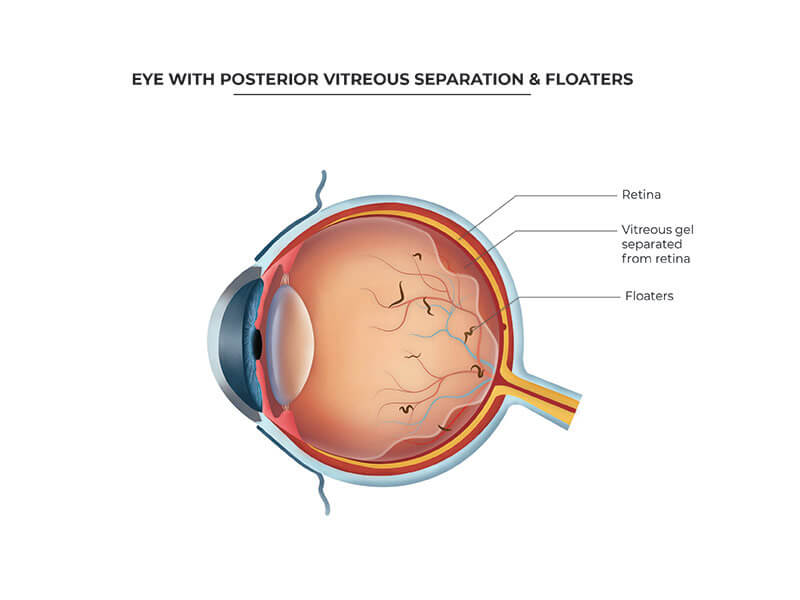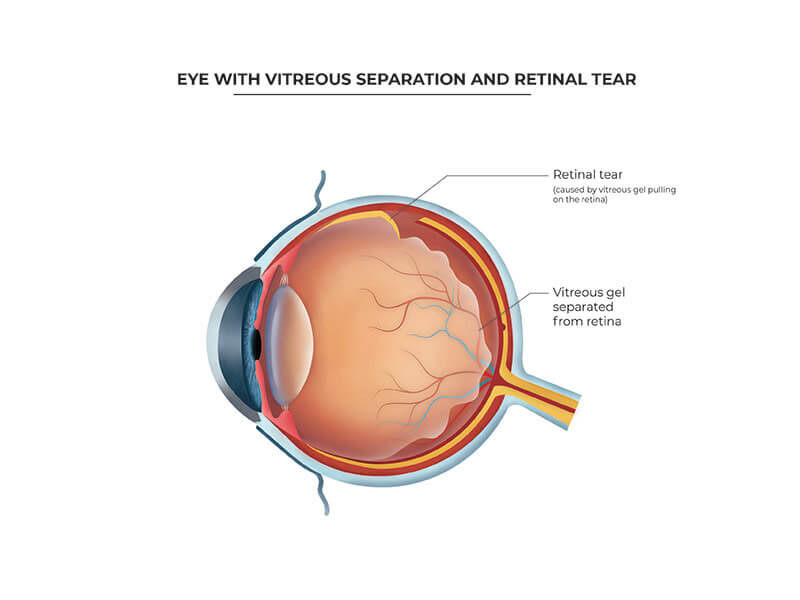Eye Floaters, Eye Flashes and Retinal Tears
What are eye floaters and eye flashes?
They are the symptoms of a vitreous separation. This is a physiological process where the vitreous (gel) separates from the retina with age.
Are all floaters a sign of a problem?
Not necessarily. They are a sign that they gel is changing in consistency with age. It is important for a dilated retinal exam to be performed to exclude a retinal tear or detachment.
I have been diagnosed with a retinal tear. How is this treated?
Laser treatment surrounding the retinal tear binds the layers of the retina and choroid together, so fluid cannot access this potential space. This decreases the chance for developing a retinal detachment.
What are eye floaters and eye flashes?
Eye floaters are insoluble proteins in the jelly-like substance of the eye called the vitreous. It makes up 80% of the volume of the eye. The vitreous is firmly attached to the retina when we are young and detaches itself from the retina with age.

Image of a normal eye with the vitreous gel firmly attached to the retina.
The retina is the thin photosensitive tissue that lines the inside of the eye. When we look at something, the retina acts like the film in a camera and captures the image.
Over time, the vitreous gradually becomes thinner and more liquid. It eventually collapses (like a collapsed spiderweb) and separates itself from the retina. This is a normal age-related process and is called a posterior vitreous detachment (PVD). It typically occurs after the age of 50 but may occur as young as the age of 20 in an eye which is near-sighted (myopic).
Posterior vitreous detachments are typically harmless and cause increased floaters in the eye. In some cases, however, there may be areas of adhesion between the vitreous and retina. This may cause a retinal tear or retinal hole to develop. Retinal tears frequently lead to a retinal detachment as fluid seeps underneath the retina, causing it to separate and detach the outer layers of the eye.

Image 1. Floaters are insoluble proteins situated within the vitreous cavity. They are usually a normal part of aging. A sudden onset of eye floaters or eye flashes needs to be reviewed by an eye specialist (ophthalmologist) to rule out a retinal tear or other causes of the eye floaters.

Image 2. An example of how eye floaters look. They are more prominent when looking at a uniform background (clear blue sky, cloudy sky) or under fluorescent light
Are all floaters a sign of a problem?
Not necessarily. Many people experience floaters when they are young and without having a PVD. These floaters are just a condensation of the protein gel in the eye. They float in the cavity of the eye and cast tiny shadows on the retina. Floaters are more likely to develop as we age and more common in people who are nearsighted, have diabetes, or who have had a cataract operation.
Most people have floaters and learn to ignore them; they are usually not noticed until they become numerous or more prominent. Floaters can become apparent when looking at something bright such as white paper or a blue sky. They are also more noticeable when viewing a uniform background.
What causes eye floaters?
There are other more serious causes of floaters, including infection, inflammation (uveitis), haemorrhaging, retinal tears and injury to the eye. In most cases floaters are part of the natural ageing process and simply an annoyance. They can be distracting at first, but eventually tend to “settle” at the bottom of the eye, becoming less bothersome.
I have been diagnosed with a retinal tear. How is this treated?
If you develop a retinal tear it should be treated with a laser. This creates a localized scar around the retinal tear and binds the outer layers of the eye together. The retinal function in the area which is lasered is lost as the laser creates a small scar, but the area of the retinal tear is already not functioning as a result of the tear and that the tiny blind spot caused by the laser is only minimally larger. The laser treatment helps to prevent a subsequent retinal detachment in the vast majority of cases.

Figure 3. This is a wide an image of a right retina, showing a retinal tear. If untreated, this retinal tear can lead to a retinal detachment.
What are the risk factors for developing eye floaters?
Certain risk factors may increase the amount of floaters, including:
- Myopia (near sightedness)
- Retinal tears
- Retinal detachment
- Inflammatory eye conditions
- Bleeding in the eye
- Trauma
- Infection
What can be done about my eye floaters?
In most cases, the severity of floaters decreases with time (months) as the larger proteins move away from the central visual axis, and the brain learns to “live with” some floaters in the vision. Vitrectomy surgery is reserved for refractory cases, where the floaters affect the quality of vision and quality of life. During a vitrectomy procedure, the vitreous gel is removed, along with its floating debris, from the eye. The vitreous is replaced with a balanced salt solution, which in turn is replaced with the body’s own fluids.
What do I watch out for after laser treatment of my retinal tear?
Any sudden increase in eye floaters or eye flashes could signify another tear and should be assessed. Any loss of peripheral vision (like a shade or curtain being drawn from your outer sight) may indicate retinal detachment and needs to be assessed promptly.
Will laser treatment for a retina tear treat my floaters?
Laser treatment creates a scar around the retinal tear, but does not do anything for floaters. For people who have floaters that are simply annoying, no treatment is recommended. Floaters can rarely be so dense and numerous that they significantly affect vision. Usually with time these will settle down and become acceptable.
Rarely, a vitrectomy operation may be needed to remove these floaters. This operation removes the vitreous gel, along with its floating debris, from the eye. The vitreous is replaced with a balanced salt solution. Surgery is not recommended unless the floaters seriously interfere with vision.